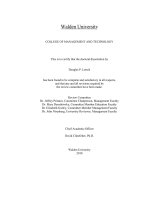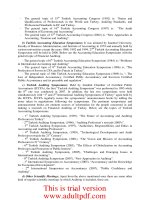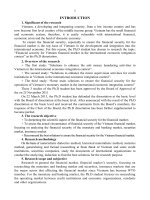Financial accounting in an economic context 8e chapter 013
Bạn đang xem bản rút gọn của tài liệu. Xem và tải ngay bản đầy đủ của tài liệu tại đây (808.37 KB, 27 trang )
Chapter 13:
Income Statement
2
What is Income (Profit)?
A measure of a change in value
– As compared to equity, which measures
the level of value (or wealth)
It
is NOT net cash flow
It
is a measure of performance
It is a link between two balance
sheets
3
Figure 13-1
4
Figure 13-1
5
Figure 13-1
6
Elements of the Income Statement
Comprehensive income - changes in net assets
from all non-owner sources; is broken into two
categories:
– net income: consisting of revenues, expenses,
gains and losses (next slide)
– other comprehensive income
Campbell’s Soup 2009 statement of Shareholders’ Equity
7
The Income Statement
Operating
1 Section
2 Non-Operating
Section
3
Sales Revenue
less:
Cost of Goods Sold
less:
Selling Expenses
less:
Administrative Expenses
Add:
Less:
Other Revenues and Gains
Other Expenses and Losses
Income Tax
Irregular
4
Items
5
Net Income
6
Earnings per Share
Discontinued Operations (net of tax)
Extraordinary Items (net of tax)
8
Two Different Concepts of Income:
Matching and Fair Market Value
The matching process:
Revenues - Expenses = Net Income
Fair Market Value approach:
FMV Net Assets (end) - FMV Net Assets
(beginning) = Net Income
9
Financing, Investing, and Operating
Transactions: A Framework
10
Classifying Operating Transactions
11
Format of the Income Statement
See Page 606 for sample format:
Sales
- COGS
= Gross profit
- Operating expenses
= Income from operations
+ Other revenues and gains
- Other expenses and losses
= Income from continuing operations (IFCO)
+/-Discontinued operations
+/-Extraordinary items
= Net income
Earnings per Share
12
Format of the Income Statement
First, note the subtotals
– Gross profit is presented when a company uses
a multi-step income statement; more relevant for
companies that are primarily retail or
manufacturing (less relevant for service
industries).
– Income from operations indicates income from
primary, on-going activity (usual and frequent).
– Income from continuing operations (IFCO)
also includes peripheral activity like interest
income, as well as potentially nonrecurring
activity like restructuring charges (unusual or
infrequent).
– Net income also includes “special” items that are
presented separately because they are
significant activities that are usually nonrecurring.
13
Format of the Income Statement
Now, more information on the “special” items below
Income From Continuing Operations (IFCO):
– discontinued operations
– extraordinary items
Note that each of these items is presented “net of
tax.” This is necessary because income tax
expense has already been calculated on IFCO.
Therefore, each level below IFCO must present the
tax effect for that component.
This is called “intraperiod” tax allocation allocation of income tax expense to different parts
of the income statement.
14
Format - Discontinued Operations
Discontinued operations (DO) relate to the disposal of
a segment of a company. Because the disposal
means that the segment activity will be discontinued,
separate disclosures are required so that investors
could distinguish between ongoing activity and
nonrecurring activity.
A segment is defined as an entire line of business or a
separately identifiable segment. For example, General
Motors would need to discontinue Chevrolet (not just a
manufacturing plant).
Financial statement presentation includes any
operating income or loss to the measurement date (the
date the board of directors declares intention to
dispose of the segment), as well as any gain or loss on
the disposal of the assets.
15
Format - Extraordinary Items
Extraordinary items (EI) are defined as those activities that
are material in amount, unusual in nature, and infrequent in
occurrence.
To determine, consider the natural, political, and economic
environment of the firm.
Examples of EI include natural disasters, nationalization or
expropriation of assets by a foreign government, and onetime major economic transactions.
If unusual or infrequent, but not both, report in “other
gains/losses”, as part of IFCO. Examples include material
write-down of receivables, and losses from an employee
strike.
16
Income Statement Format - Other Issues
Consistency requires the use of the same accounting
method from year to year.
However, a company may choose to change to an
alternative accounting method (ex: DDB to SL or FIFO
to average).
Also, a company may be required to change to a new
accounting technique by the issue of a new accounting
standard.
Accounting standards required companies to show the
cumulative effect for prior years’ income on the
current income statement in a special category called
“change in accounting principle.”
17
Income Statement Format - Other Issues
This special category allowed investors to
analyze IFCO for the current year separately
from the effect of the cumulative change.
Problem: This “cumulative” calculation was
reported as part of current net income, even
though it relates to prior years’ net income.
Solution: In mid 2005, FASB eliminated this
category from the income statement. Now all
changes in principle receive either a retroactive
restatement (like errors of a prior period) or a
prospective treatment (like changes in estimate).
18
Figure 13-5
19
Earnings Per Share (EPS)
SFAS 128 simplified the presentation of earnings per share to two
components:
– basic EPS
– diluted EPS
Calculation of Basic EPS =
Net Income - preferred dividends
Weighted average common shares outstanding
Concept: To indicate how much each common shareholder “owns” with
respect to earnings.
Preferred dividends are deducted - if declared or if cumulative because they are “owed” to preferred shareholders.
This is a calculation of “what is” - the numerator and denominator use
actual shares outstanding and actual net income for the year.
20
Earnings Per Share (EPS)
Class problem:
Bush Company reported net income of $30,000 in
2007. The company had 60,000 shares of common
stock outstanding for all of 2007. Bush also had
5,000 shares of convertible preferred stock
outstanding for all of 2007. During 2007, the
company declared a $4,000 cash dividend to
preferred shareholders. Each share of preferred
stock is convertible to 4 shares of common stock.
1.Calculate basic EPS:
$30,000 - 4,000 = $0.43 per share
60,000
(Note that the convertibility component is ignored for
basic EPS.)
21
Earnings Per Share (EPS)
2. Calculate diluted EPS:
$30,000 - 0 _ = $0.38 per share
60,000 + (5,000 x 4)
Note that the convertibility component is assumed to
have been exercised for diluted EPS. If the PS
was converted to CS at the beginning of the year,
there would have been NO preferred dividend,
and there would have been 20,000 additional
shares of common stock outstanding all year.
The effects for convertible bonds and employee
stock options are similar for diluted EPS.
22
EPS Disclosure
Separate EPS disclosure for:
– Net income from continuing operations (after
tax)
– Disposals of business segments
– Extraordinary items
Calculation
– Separate dollar amount (from above
categories) divided by number of common
shares outstanding
If diluted EPS exists, the company should also
calculate diluted EPS for each level of
presentation.
If diluted EPS is antidilutive (the calculation is
actually higher than basic EPS), the company
does not have to present diluted EPS.
23
Problems with EPS
The numerator can be manipulated by a number of
earning management techniques.
The denominator can be manipulated by stock buybacks
(treasury stock).
The “what-if” presentation of diluted EPS is a fictitious
number - it can never actually happen. The potentially
dilutive securities have not been converted at year end,
and they can never have claims to the current year’s
income. The only benefit of diluted EPS is that it can
indicate the magnitude of the maximum potential dilution
for the future.
24
Economic Consequences of Reporting
Net Income
Investors focus heavily on income and related indices like
earnings per share and the P/E (price per share to
earnings per share) ratio.
Recent announcements (noting that the reported EPS was
off the estimate by as little as a penny) have caused the
market price of reporting companies to drop significantly.
Because of investor focus, and because of compensation
bonuses, managers continue to focus heavily on the
bottom line, sometimes with dire effects.
Expanded financial statement disclosure and increased
awareness by investors may drive this earnings fixation.
25









